Consisting of a Bigfoot 30C10.11 and Mitsubishi Fuso FG140, the Basecamp Expedition Vehicle (BEV) pushes truck campers into a new territory. For the Hackneys, off-road is where the adventure begins, and time is the real enemy.
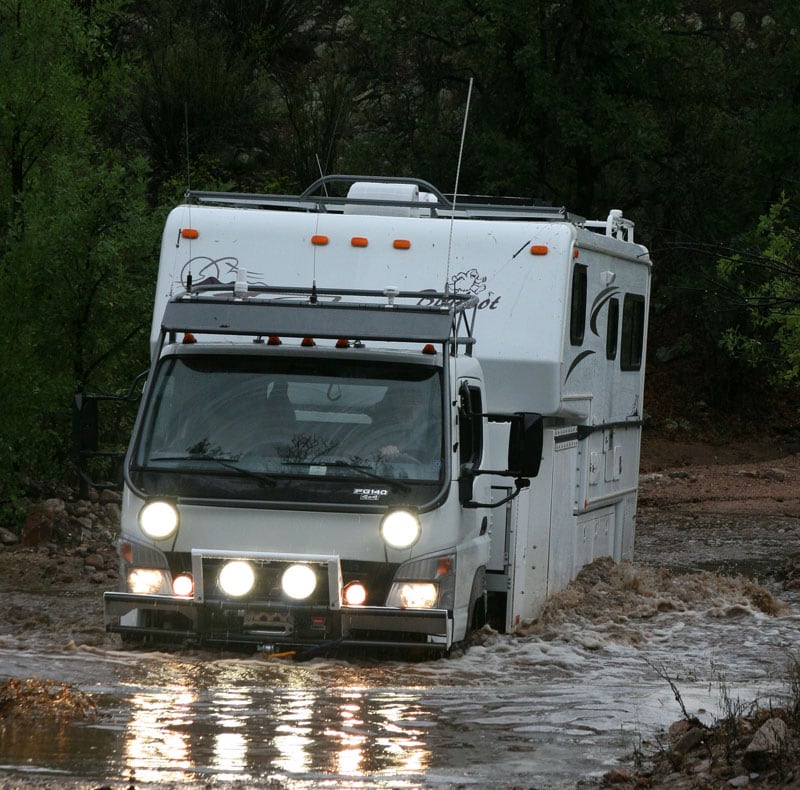
Above: Water crossing in Santa Maria Mountains, Arizona
Doug and Steph Hackney sent us a travel resume that is almost hard to fathom. For starters, they’ve traveled on six continents and through forty-three countries via every mode of transportation imaginable. They also have an extremely custom truck and camper they call the Basecamp Expedition Vehicle (BEV).
Most of us think a truck camper is a pickup truck with a standard pickup bed and a de-mountable truck camper. Doug and Steph Hackney’s Basecamp Expedition Vehicle (BEV) challenges this definition and makes us take a new look at the versatility of a truck camper.
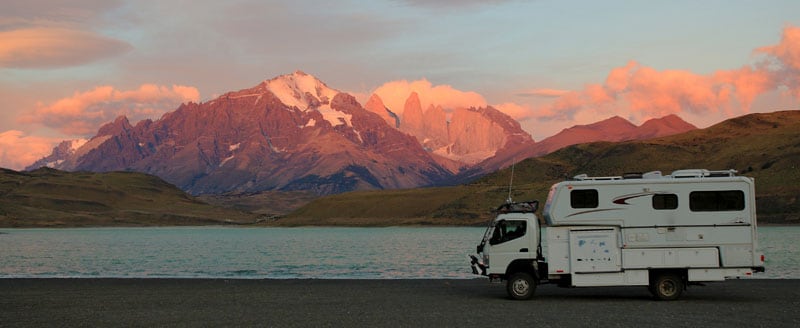
Sunrise near Torres del Paine National Park, Chile. All photos by Douglas or Stephanie Hackney unless indicated.
Where do you think your desire to explore every inch of our planet came from?
Steph: I am a military brat and my parents and I moved twenty-one times by the time I was sixteen! My mom is from Germany and we traveled back and forth between there and the United States, as well as to other European countries. I guess you could say that it’s just part of who I am, as well as how I grew up – nature and nurture.
That said, traveling to remote areas was not part of my upbringing. In fact, it was rather scary for me when we started. And now? Well, now it’s my preference!
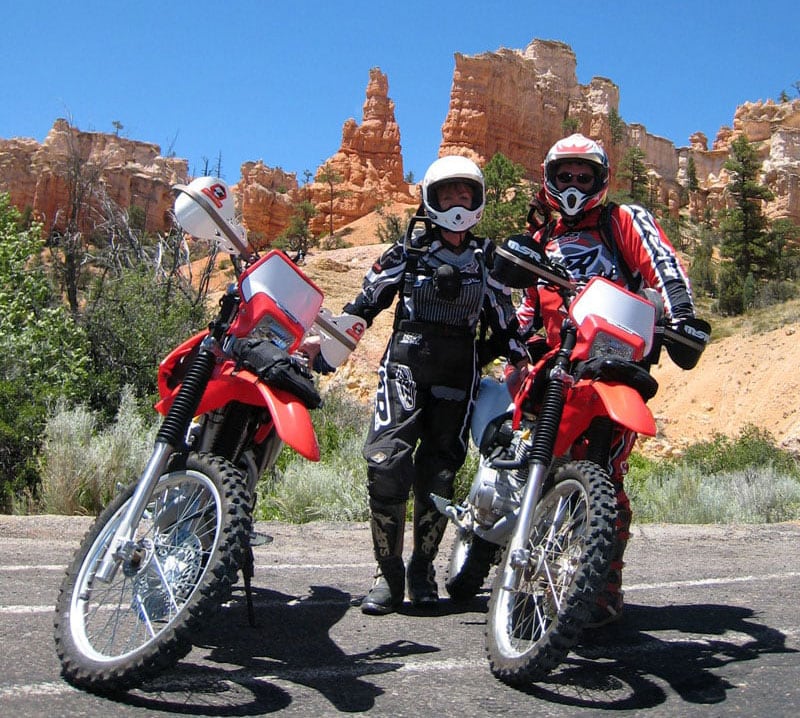
Above: Steph and Doug enjoy different modes of travel near Bryce Canyon National Park
Doug: I remain driven by an unquenchable thirst for learning, knowledge, growth and discovery. I think I get it from my grandparents, Clarence and Frances Hackney. Their home was always full of National Geographics, Popular Mechanics, and other magazines. They supplied me with an endless stream of books by Jack London, Jules Verne, etc. And the farm shop was always open and available for anything I wanted to disassemble, invent or create.
Back in December of 2002, I passed the milestone of a million actual flight miles (that’s miles traveled in airplanes) on United Airlines. I wrote the crew of the plane I was on when I passed the one million mile mark a little note along with a restaurant gift certificate. I think the note encapsulates the source of my wanderlust and thirst for adventure pretty well:
Fellow traveler – Forty years ago, on this day, at 5:12pm, I was standing next to the Rock Island Railroad tracks that ran behind my grandfather’s farm in Iowa. At exactly that time every day, the Rock Island Rocket passenger train would roar by. There I would be, waving at the engineers and peering into the windows of the cars, straining to catch sight of the passengers within.
As their faces flashed by, I would wonder, “Where are they going? What adventures are they having?” As the train disappeared into the setting sun, I would turn and walk back to the farmhouse, my gaze moving skyward. There I would see the contrails of the new jetliners lacing the sky, stretching from horizon to horizon. Still awaiting my first train ride, I could scarcely imagine the glamour and excitement of air travel, especially on a jet.
At night, long after my grandparents had gone to sleep, I would lie awake reading the stacks of National Geographic magazines and the ever present novels of adventure and discovery: Treasure Island, Huckleberry Finn, Tom Sawyer, the collections of Jack London, Tom Swift, and The Hardy Boys.
As I filled my imagination with the wonder and allure of far away places, from miles away the rotating beacon of the Newton Airport would sweep across the house and paint the walls with alternating pulses of white and green. That airport beacon became the heartbeat that powered my wanderlust, my imagination, and my endless thirst for discovery and adventure.
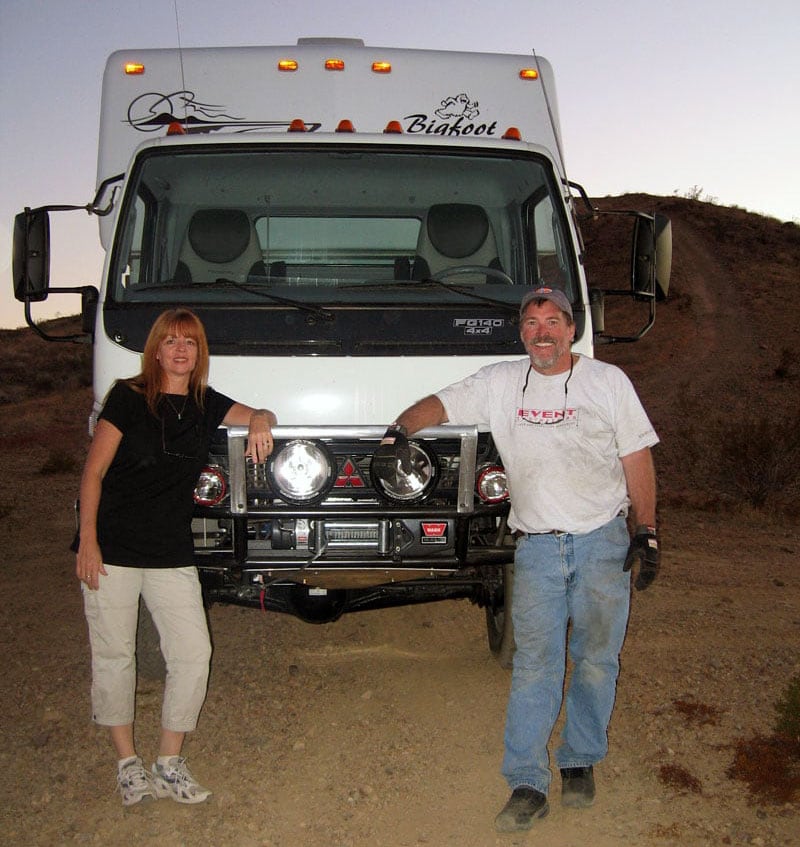
Above: Steph and Doug Hackney with their Bigfoot 30C10.11 truck camper and Mitsubishi Fuso FG140
Should there be a bumper sticker on the rear bumper of the BEV that says, “I’d rather be sailing?”
Doug: Yes. Sailing across an ocean, standing solo at night watch, alone but for the stars and the sea, is where my soul is at peace. But, I didn’t find anything in sailing that was worth losing Steph, so here I am.
Steph: It’s a long story, but the short version is that I have a life-long fear of drowning. Even a beach baby such as myself can be afraid of the open water. I was terrified – yes, I said terrified – of being in the open water.
I was especially freaked out at the prospect of sailing for days and weeks without seeing land. But, I wanted to overcome the fear and help my husband to fulfill his new dream of sailing around the world. So I took sailing lessons and accompanied him to the British Virgin Islands where we chartered a boat to “test” the concept.
“Traveling to remote areas was not part of my upbringing. In fact, it was rather scary for me when we started. And now? Well, now it’s my preference!”
While I loved the British Virgin Islands, and was quite content when moored or anchored, I was petrified when we sailed out into the Atlantic and land was not within a few hundred yards. I knew then I would never be able to do it.
Having to tell my husband that I could not sail around the world was one of the toughest things that I have ever had to do. The disappointment on his face tore my heart out. But, I knew, based on great advice from a lifelong sailor named Jimmy Cornell, that, “…at some point, you have to love sailing.” And, I just didn’t.
Do you have any regrets about your expedition or is it everything you dreamed about?
Steph: I have none. How can one have any regrets about being able to take time off from work and everyday life to see what we saw, and regret it? Would I change anything knowing what I know now? Sure, but I don’t for one minute regret the experience.
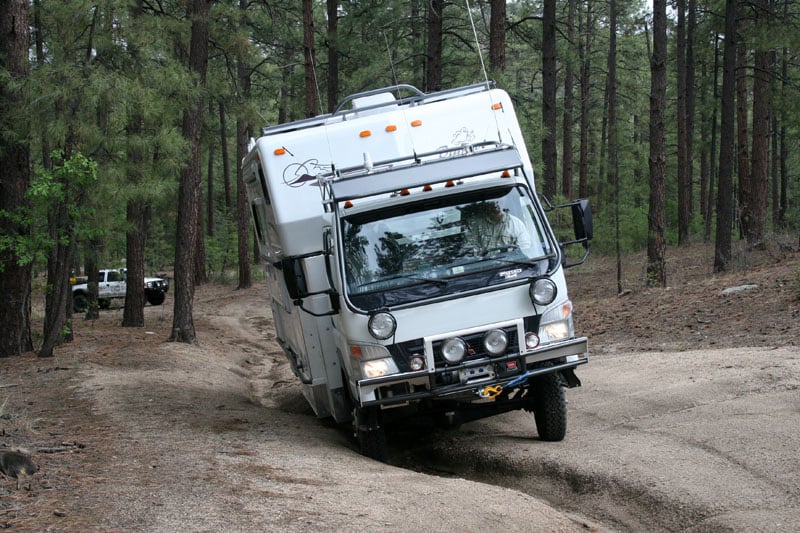
Above: Chassis Roll Angle Tests and 4×4 Training near Prescott, Arizona
Doug: I would have gotten Steph out on the open ocean very early on in the process so we didn’t waste years and lots of financial resources on that concept.
I would have either built on a bigger truck or put less weight on the truck. More radically, I might have either purchased a factory RV based on a two wheel-drive Mercedes Sprinter platform and shipped that overseas, or used the fly and buy methodology; fly into the continent, purchase a local market vehicle, use it to explore, sell it and repeat.
Both of those options would have saved us a lot of money and, more importantly, saved us a lot of time. Time is always the most precious commodity.
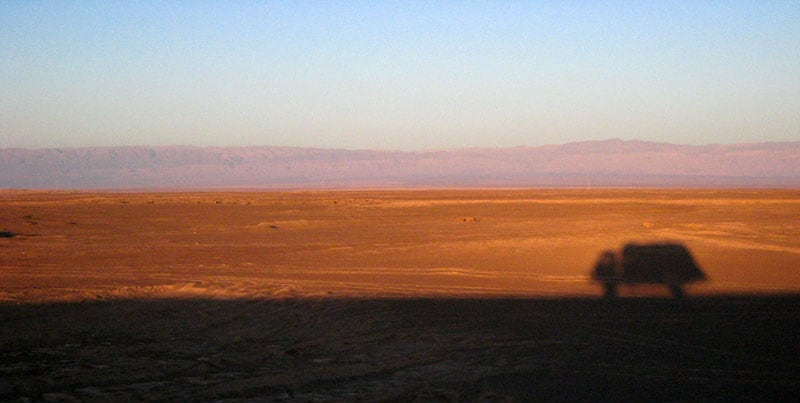
Fuso shadow portrait. Atacama Desert (driest desert in the world). Northern Chile.
That’s an important perspective for fellow overlanders. Overall, how has the rig performed for you?
Steph: In my opinion, it has performed beautifully. It is everything we hoped it would be, and more. It enabled us to live our dream. But I was not responsible for ongoing maintenance.
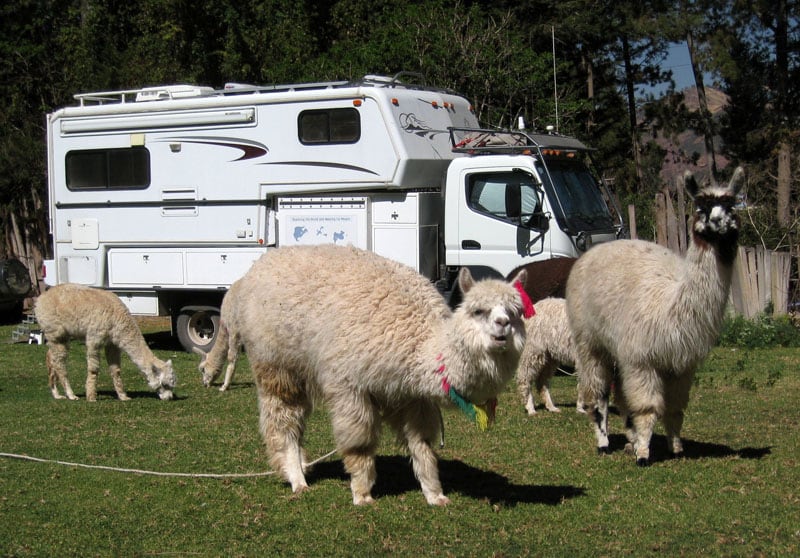
Above: Llamas in the campground in Cusco, Peru
Doug: There have been no issues with the Fuso or the Bigfoot or any factory engineered system. The only issues we have had are with things we have designed, engineered and installed.
We made a mistake in how we designed and implemented the camper’s sub-frame and put too much weight on too small of a truck. These things, along with winching a huge Mercedes expedition vehicle out of the mud, led to failure of the frame on the Fuso. In my opinion, that failure was not related to the engineering or manufacturing of the truck.
Otherwise, the vehicle has met all of our design goals and has been a great platform for exploring the western United States and South America.
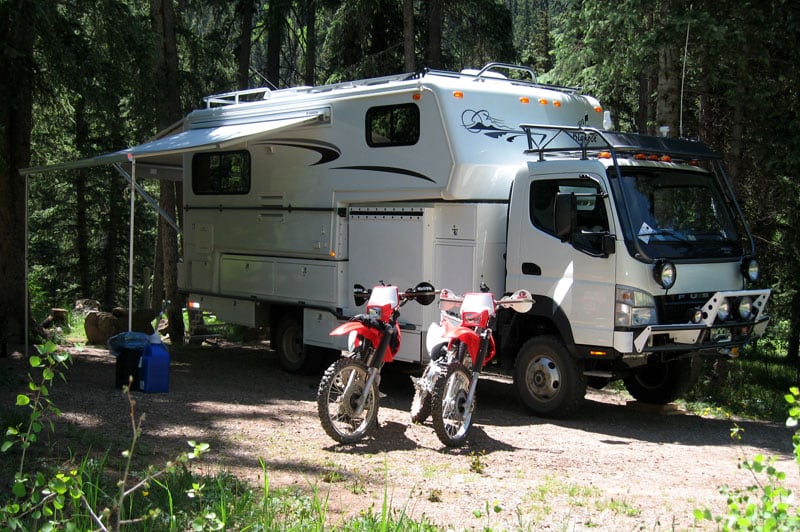
Above: Campsite in the Uncompahgre National Forest, Colorado
At the heart of your Basecamp Expedition Vehicle (BEV) is a Mitsubishi Fuso FG 140 and Bigfoot 30C10.11. How did you choose this combination?
Steph: We were originally looking at a Bigfoot travel trailer. We were leaning towards Bigfoot because they are so well made for extreme weather conditions. We knew we would be facing weather challenges in places like Patagonia.
We came across the pick-up camper on our initial test of the camping/overlanding concept while we were in Canada in a rental camper. I suggested we take a look at one and we really liked what we saw.
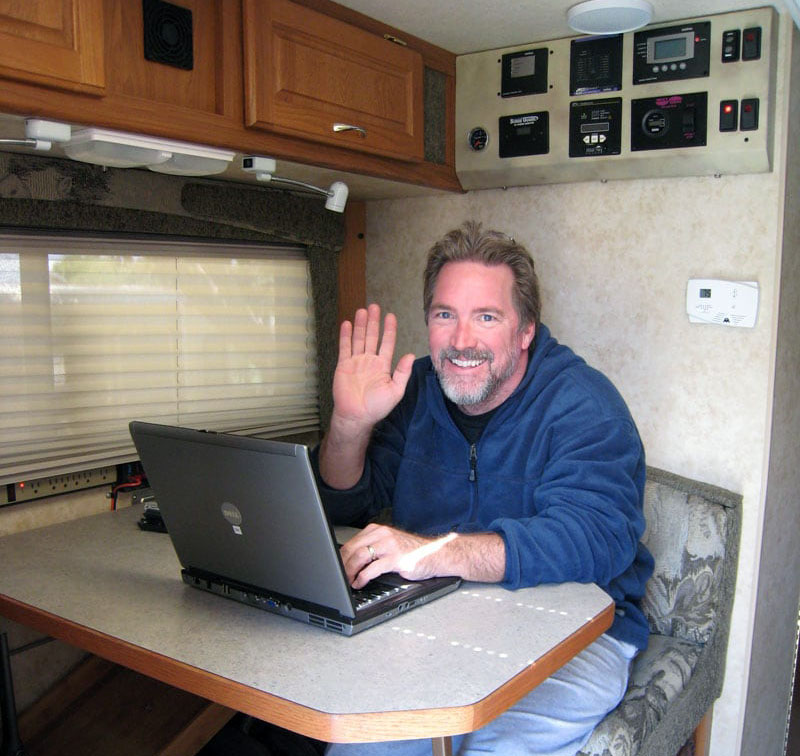
Above: Doug at the dinette. The controls are above his head, top L to R: Xantrex auto generator start, Xantrex 220V/50-60Hz battery charger, Xantrex system controller; bottom L to R: main LP/Propane tank fuel level gauge, Surge Guard auto transfer switch, Blue Sky solar panel controller and generator switch.
The inside space was drastically different from those made back when Doug was camping with his family, and the quality of the Bigfoot was superb. But, the biggest plus of the truck camper was that the overcab area in the front of the camper enabled us to create a garage underneath where we could store motorcycles, riding gear, parts, chairs, etc.
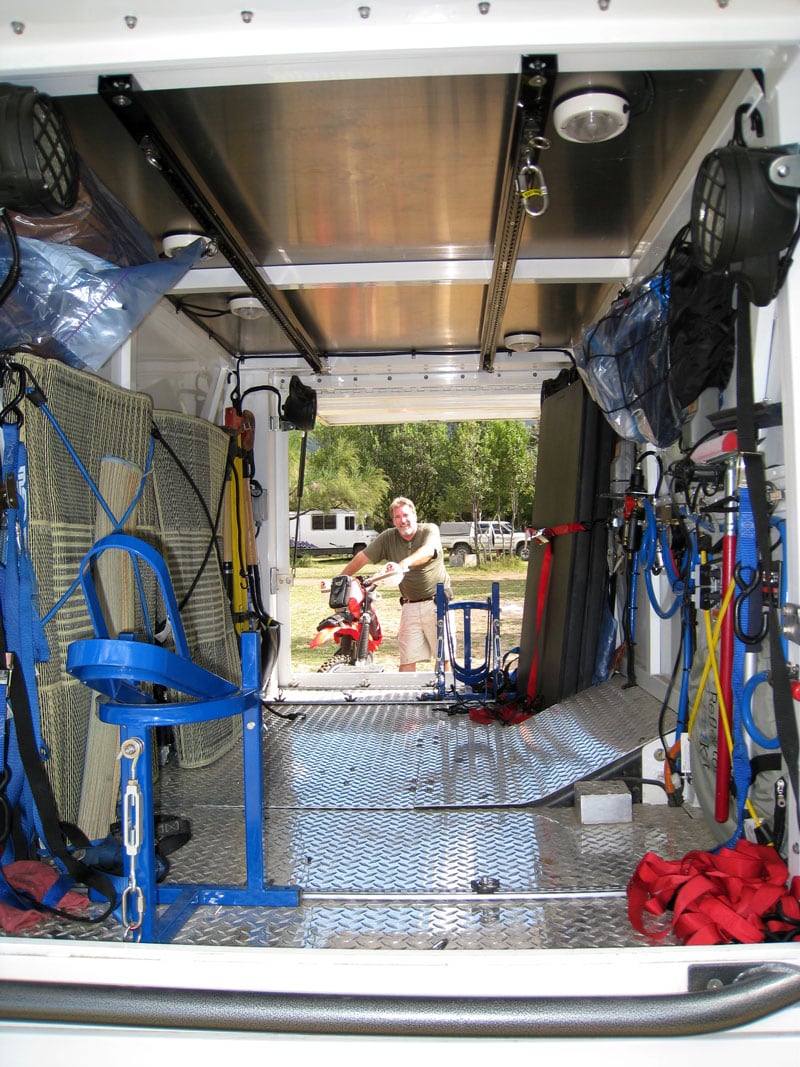
Above: Unloading the bikes – under the cabover area. Camped in northern Patagonia, near Baraloche, Argentina.
Doug: When Steph decided she could not go out on a sailboat, I had just a few weeks to research and design a solution. I had spent years (literally) researching sailboats, so I felt that I came into the expedition vehicle concept under-researched, under-experienced and under-prepared. Our first option was a Toyota Land Cruiser with a roof-top tent, commonly used in Australia and Africa for expedition travel.
“The fact is you can see at least 95% of the world’s interesting places in a two-wheel drive Volkswagen van.”
We ended up with the Fuso and the Bigfoot. It was a very intense, short time period between those two points. Once we became convinced that a Land Cruiser size vehicle was too small (along with the fact that Steph declared herself, “not a tent kind of girl” for a two to three year expedition) I was pushed upward in truck size.
We needed something with worldwide parts and service. We needed a cabover/forward-control truck to maximize the payload. We needed diesel for worldwide fuel availability.
We were convinced that we needed a four wheel-drive chassis. There is only one four-wheel-drive, cabover, diesel, medium-duty truck sold in the United States; the Mitsubishi Fuso FG 140.
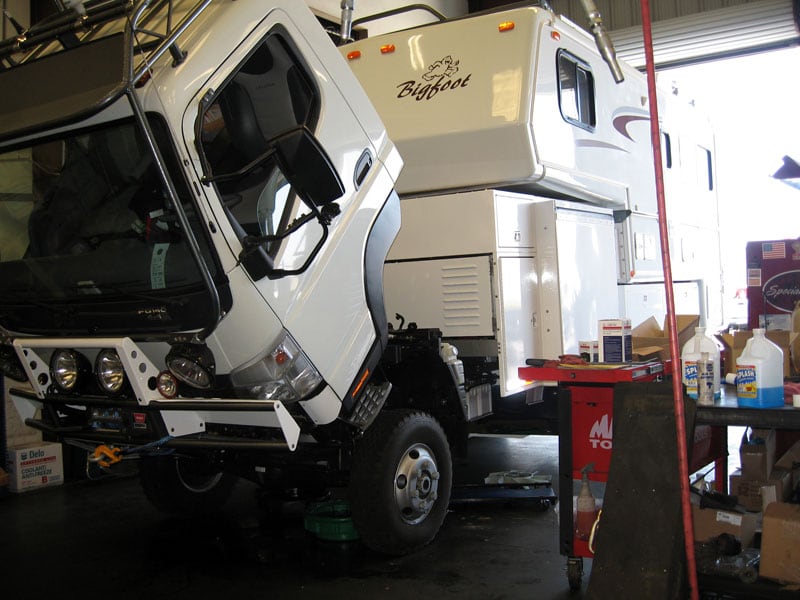
Above: First service at 2,500 miles; all fluids, grease and a warranty recall update to the cooling system
Once I had the chassis, it was a very short leap to proven combinations. Carl and Mary Hunter went around the world and then a year in South America in a Fuso/Bigfoot trailer combination. Once I discovered their vehicle, I felt I could reproduce it and we could get underway quickly.
Because of our financial planning, every day we spent in California meant many fewer days traveling. We rented the smallest camper we could find and spent six weeks in British Colombia as a proof of concept on the lifestyle. While there, we toured the Bigfoot factory with the intention of using a trailer on the truck, as Carl and Mary had done.
On the way to the factory we stopped by a Bigfoot dealer and Steph stepped into a Bigfoot truck camper. She soon stuck her head back out and said, “Hey, you should check this out, it’s really nice inside”. I replied, “There’s no way we are using a truck camper”.
I hadn’t been in a truck camper since the tent camping days of my youth when my Uncle Dick and Aunt Wanda had one. All I remembered was the typical camper construction and materials of that era. Steph, as only she can, wore me down and I finally agreed to step inside. Needless to say, the truck camper market has come a long way since the 1960s.

Above: BEV alpha test. Sunrise over the Sea of Cortez, Bay of Los Angeles, Baja California, Mexico
After exploring with motorcycles and tents, what was it like to switch to the BEV?
Steph: It is pure luxury in terms of living. We have plenty of space and it is so nice to have our home with us. It does restrict us in terms of places we can go (the bikes can go virtually everywhere) and can make integrating oneself into a community a bit more challenging.
The benefits are that we can stay almost anywhere without having to worry about finding a hotel. We can make meals ourselves using the fresh ingredients we find along the way. We always have a comfy bed and clean shower.
We have a nice place to recover in case of illness or injury. We always have a warm or cool place to be in the event of extreme weather. And the costs are minimal – fuel and groceries (well, and wine, of course).
Doug: The biggest downside to a truck, or really of any four-wheeled vehicle, is that you tend to cocoon yourself inside the vehicle. The more comfortable the vehicle, the greater is the temptation to cocoon.
A motorcycle, by contrast, is an instant icebreaker anywhere in the world. Every guy you meet has almost always had an uncle, father or cousin with a scooter or motorcycle, and they all want to talk about the bike. When the women see Steph take off her helmet and realize she’s a woman, they all want to talk to her about her experiences.
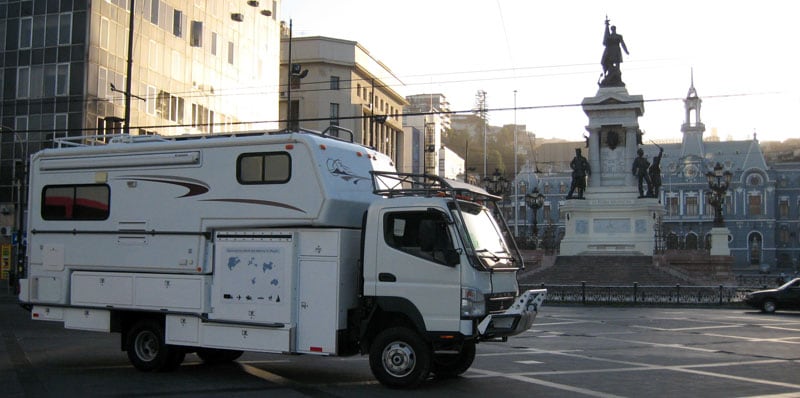
Above: Plaza in front of the Armada Naval headquarters and memorial in Valparaiso, Chile
The truck, in contrast, is its own little world, and does not serve as a conversation starter (with the exception of campgrounds in the United States and Canada).
A truck the size of ours (length: 27.17′ / 7.98 meters, height: 12.04′ / 3.67 meters, width: 8.58′ / 2.62 meters) is inherently self-limiting on where we are willing to take it.
Note that the truck is capable of going to places we would never venture because (a) we’re not super-experienced 4×4 people, and (b) it’s our only home and we’re not going to risk it on an unknown two-track shelf road. We mitigate those limits with the two small dirt bikes we carry in the garage (Honda CRF150F, street licensed), which allow us the freedom to explore anywhere, even, and perhaps especially, where four-wheeled vehicles cannot go.
Our truck and camper are extremely comfortable. The luxury of having safe (filtered and sterilized) water everywhere, of being able to store and cook our own foods, and of having our own berth and head (bed and bathroom, sailing terms die hard) is very meaningful over the span of a two to three year expedition.
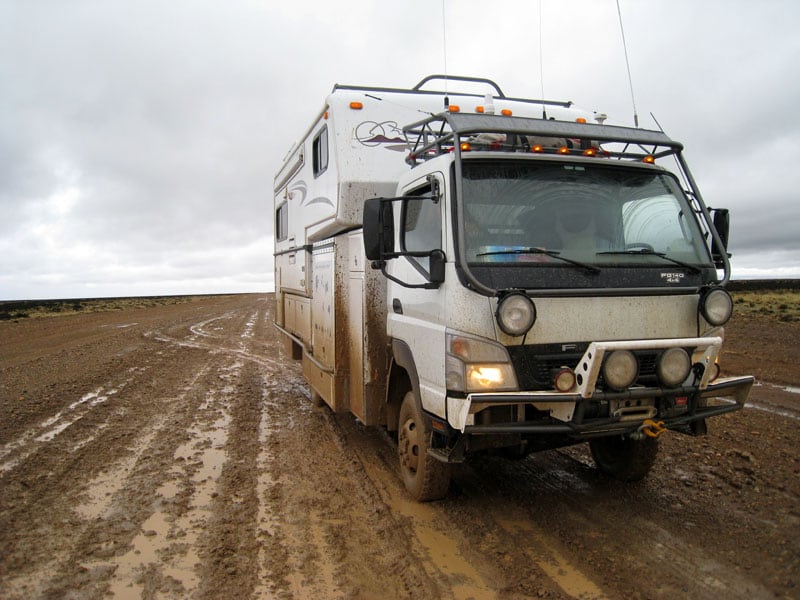
Above: Muddy stretch of Route 40, a legendary road in Patagonia, Argentina
What extremes have you put the BEV through – temperatures and road conditions?
Steph: Patagonia. Enough said.
No, really, it has been through a lot. Between very rough and pothole-riddled roads, non-stop rain and wind like nothing we had ever experienced (there is no wind like that in Patagonia), it has been tested again and again. And, our Fuso has come through it all. But then, we built our Fuso for this kind of adventure.
Doug: As the numbers below attest, we’ve checked the boxes on many of the extremes that people fret about so much when they consider a journey overseas.
Distance: ~28,000 miles/ 45,062 kilometers.
Days: 648. Nights in camper: ~559.
Roads: mix of freeway, one and two lane paved, one and two lane unpaved, gravel, silt, sand, dirt, mud, rock, two-track, non-maintained, and no-road.
Terrain: flat, rolling and mountains, grades greater than 16%; temperate, deserts (including the driest in the world), rain forests.
Temps: 14.5F / -9.7C to greater than 110 F / 43.3 C.
Elevation: sea level to greater than 16,000 feet / 4,877 meters. Deepest water crossing: ~ 46 inches / 116.84cm – 1.168m.
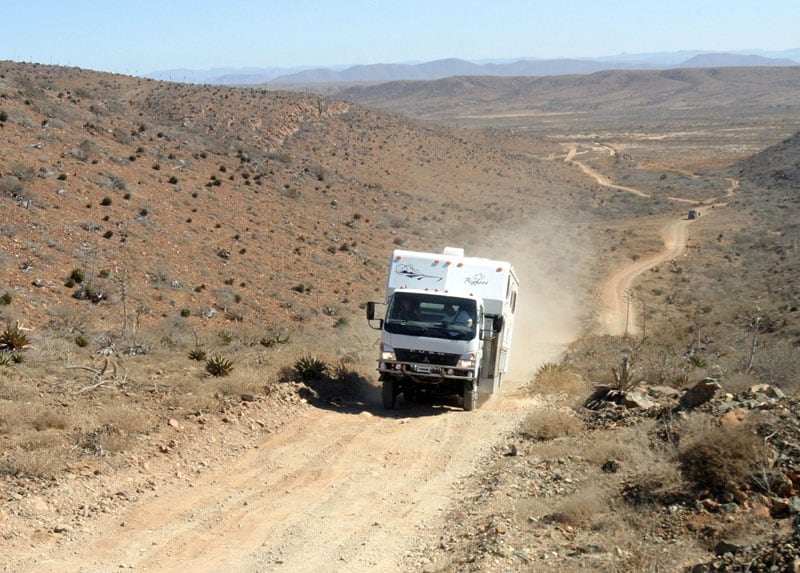
Above: Climbing the hill to Alajandro’s surf beach. BEV alpha test in Baja California, Mexico. Photo by Kathy Stajic.
Have you needed to use the integrated self-recovery and extraction capabilities of your rig?
Steph: We did winch another overland vehicle out of the mud, and then used them to winch ourselves out. But, that was the only time, and it was in a campground!
Doug: The reality of overlanding (unsupported travel by vehicle) is that you spend most of your time on market town roads – the roads that connect market towns together or with cities. Those roads are used by the medium and heavy-duty trucks that carry the goods to and from the market towns.
You use the market town roads to go from one interesting place to another. While some of those market town roads would certainly not be considered roads by a typical American, Canadian, or European, they are no problem for most vehicles. The fact is you can see at least 95-percent of the world’s interesting places in a two wheel-drive Volkswagen van.
Almost all the capabilities you build into a vehicle to handle the extremes go unused for almost all of your travels. For the rest, it makes more sense to rent something local (burro, Toyota Hilux, etc.) than to attempt to build all that capability into your vehicle or suffer the effects of a very capable vehicle (noise, vibration, ride, handling) for the 98-percent of your journey where you don’t need it.
“Most importantly – it’s not about the vehicle, it’s about the experiences.”
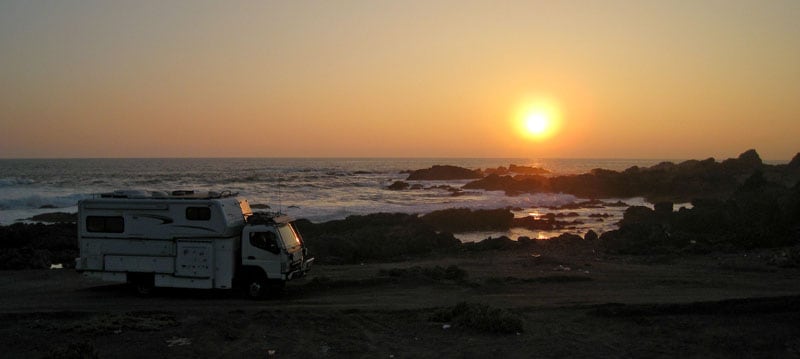
Above: Pacific Ocean sunset at a campsite north of Taltal, Chile
What would you tell someone who wanted to build a similar vehicle to your BEV?
Doug: Go earlier with less versus later with more. Every single penny you spend on your vehicle is almost certainly better spent on your travel. Fly into your destination and buy a local vehicle (local parts, locally serviced, local resale market, etc.) and start exploring.
Four-wheel-drive is highly overrated. Uber capable vehicles such as a Unimog are usually reflections of the owner’s ego or incorrect perception of vehicle capability requirements, not of the realities of overlanding. And most importantly – it’s not about the vehicle, it’s about the experiences.
Tell us about your security system design and capabilities.
Doug: I’m assuming you are referring to the security systems we implemented. Everything has worked, but I think they have been largely unnecessary.
The thing that is almost impossible to know or realize inside the fishbowl of the United States, Canada and Europe is that the world is a very warm and welcoming place. Aside from a very few rare exceptions, you are much safer overseas than you are in the United States. And I’m including in that assessment traveling via motorcycle in the Middle East just after the war started.
Your biggest challenge outside the post-development countries (United States, Canada, Europe, and Japan) is fending off the generosity and welcome of the locals.
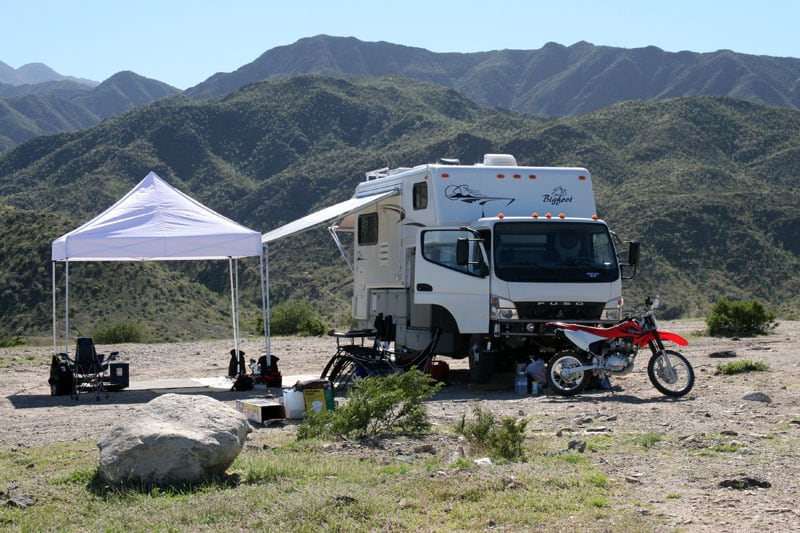
Above: Bay of Los Angeles, Baja California, Mexico
Self-sustainability is an important part of your experience. Tell us about that facet of your journey.
Doug: As you might expect, our static carbon footprint is a fraction of what it was in our house in Carlsbad, California. However, when you start driving around the planet at 10-miles per gallon, it isn’t quite as impressive a savings.
Two of our goals for this chapter of our lives are to explore living more simply and to learn more about being energy independent. We discovered that simple living greatly aids the goal of energy independence, and that surprisingly, you can become much more energy independent without significant impact on your quality of life.
Keep in mind that we chose comfort and convenience over ultimate vehicle capability every time during the design and construction of our vehicle, so we have what can only be termed a “Hyatt in the Woods” living experience. We essentially lack for nothing in the way of modern conveniences, save a garbage disposal. And even with that very comfortable lifestyle, we use a tiny fraction of our previous lifestyle’s daily energy.
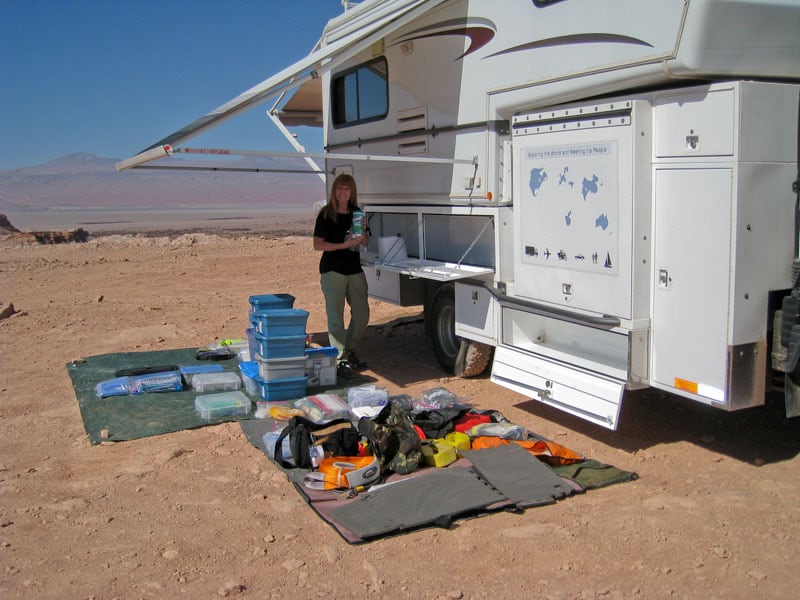
Above: Cleaning and reorganizing the passenger’s side storage bins in San Pedro de Atacama, Chile
Has the performance and durability of the Bigfoot truck camper matched your hopes and expectations?
Steph: Personally, I could not be happier. It has done everything we asked of it and provided a cushy home for us in diverse climates and environments.
Doug: My repair and maintenance on the Bigfoot camper has consisted of; one, tightening the handle on the bathroom roof vent twice, and two, re-packing the insulation above the berth (bed) ceiling due to condensation while camped in one of the wettest spots on earth for several straight weeks of rain and high humidity.
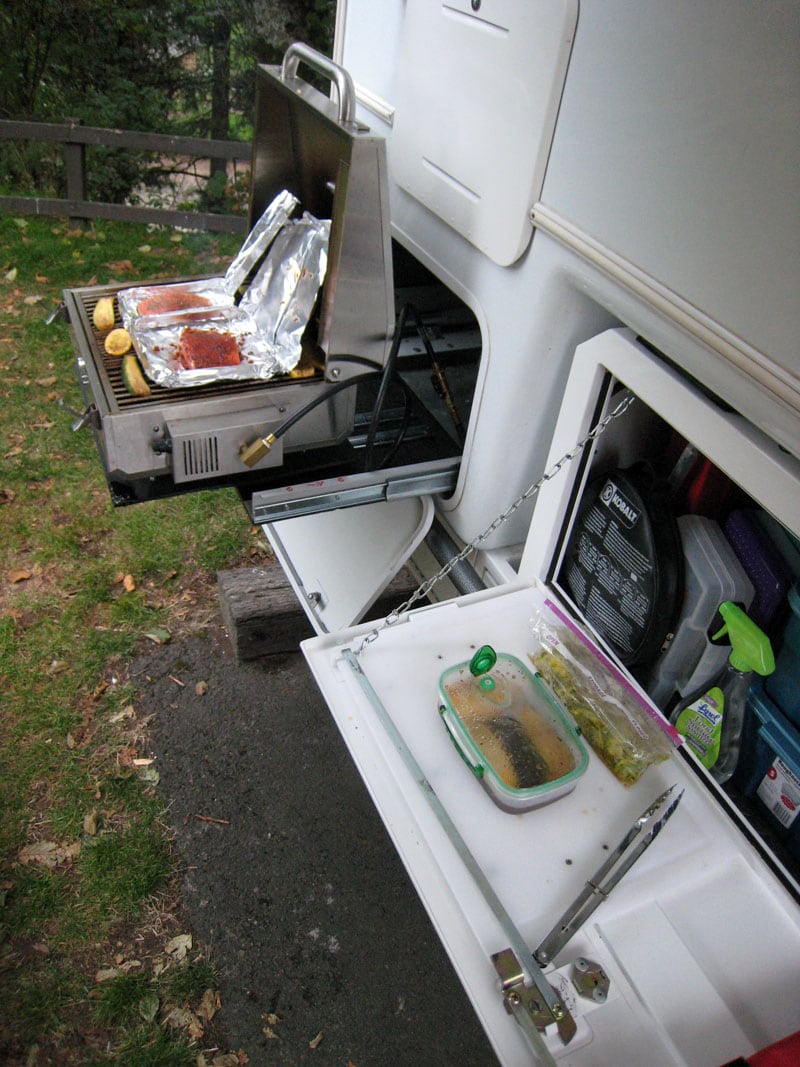
Above: The BEV grill and cutting board deployed in Astoria, Oregon
Your calendar timeline has a lot of, “design, create, and install”. Who was doing all this designing, creating, and installing?
Steph: Doug, Doug, Doug! The build was a long process during which time I only saw my husband when I came to work on some rig-related projects (like organizing and procurement), or on the nine days he took off in those nine months.
How he kept up that pace is beyond me. He did have a wonderful shop to work in, and some very talented and helpful people working alongside him. I’m sure that was key to him surviving the build without losing his mind, completely.
Doug: Really, the whole nine-month (twitch), ten to fourteen hours a day (twitch) build process didn’t have any noticeable effects (twitch) on me at all (twitch). Just kidding.
Mark Johnson of Metal Tech Innovations did all the metal work (engineering, fabrication, welding, etc.). I did all the other systems. I don’t recommend the experience.
The upside of the build experience was that I knew every nut, bolt, wire and hose that made up our rig. The downside is that it took much too much time and cost way too much money. Of these two, time was by far the greater loss.
Since our financial plan was based on sailing over the horizon, every day we spent in California burning through our money while building the rig meant many less days of travel. This is an important lesson for people considering how to structure and manage a life chapter of full-time world overlanding. Time is the enemy.
Doug and Steph Hackney’s Rig
Truck: 2007 Mitsubishi Fuso FG140, day cab, straight truck (cab & frame rails only, no stock body), 4×4, diesel
Camper: 2006 Bigfoot 30C10.11 3000 series
Tie-downs and Turnbuckles: Custom
Suspension Enhancements: Custom Deaver spring packs, custom rear sway/anti-roll bar, Bilstein shocks
Gear: Designed and built for third world global exploration, fully self-sufficient, air seats, dual 16,000 pound winches (front and rear), custom exterior storage boxes, custom garage storage, custom bumpers, 30-amp diesel generator, marine grade electrical wiring and system components, solar panels, water filtration and sterilization system, broadband satellite communications
This incredible article originally ran in 2009 as a two-part series and has been unpublished since 2012. The updated article has been combined into one, refreshed with larger photographs and re-published to celebrate its 10-year anniversary.
